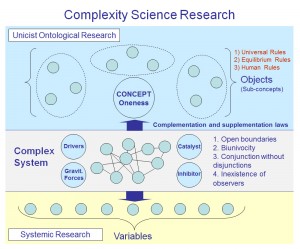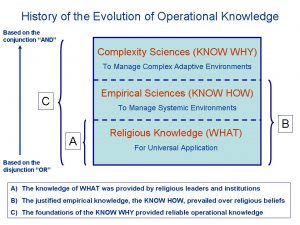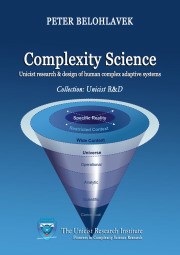What are Complexity Sciences?
The objective of the Unicist Approach to Complexity Sciences developed by Peter Belohlavek was to find a scientific approach to understand nature and provide a structure to emulate it when designing, building or managing complex adaptive systems.
 Belohlavek developed the epistemological structure for complexity sciences, by developing the unicist ontological methodology for complex systems research, which substituted the systemic approach to research adaptive systems and was materialized in the unicist logical approach to deal with adaptiveness.
Belohlavek developed the epistemological structure for complexity sciences, by developing the unicist ontological methodology for complex systems research, which substituted the systemic approach to research adaptive systems and was materialized in the unicist logical approach to deal with adaptiveness.
This is an excerpt comparing the different approaches that intended to deal with Complexity Sciences.
It needs to be stated that the unicist approach developed the first integrated structure to manage complex adaptive systems.
Until the existence of this approach the methods of systemic sciences were used as a palliative to deal with complex adaptive behaviors.
Expanding the Boundaries of Sciences
As it is known, the management of complexity has been an unsolved challenge for sciences. This challenge was faced in 1976 by The Unicist Research Institute that was a pioneering organization in finding a structural solution for complexity without using artificial palliatives.
The paradigm shift, based on the emulation of nature, was developed to solve the need of having reliable knowledge to deal with complex environments. It was provoked by the fallacy of considering empirically-justified knowledge as reliable knowledge.
It allowed managing complex environments as a unified field.
The paradigm shift was triggered by the need to understand complex adaptive systems. The shift implies having subordinated the empirical approach to sciences to a pragmatic, structuralist and functionalist approach to deal with complex environments that integrates, at an operational level, the preexisting empiricism.
This is a superior level in sciences that integrates complexity sciences with systemic sciences using the double-dialectical logic to emulate the ontogenetic intelligence of nature and using objects to emulate the organization of nature.
The scientific evidences of the Unicist Theory
In this document you will find seven scientific evidences of the Unicist Theory, which confirm its functionality, that allows dealing with complex systems. These evidences are:
- The functionality of amino acids
- The structure of atoms
- The structure of biological entities
- The nervous system
- Similarity between natural and social objects
- The homology between the unicist concepts and the stem cells
- The homology between thinking processes and the functionality of electricity
Access the scientific evidences: https://www.unicist-school.org/complexity-sciences/scientific-evidences/
Complexity Science Research
The unicist theory expanded the frontiers of sciences making the scientific approach to complex adaptive systems possible without needing to use arbitrary palliatives to transform complex systems into systemic systems in order to be able to research them.
 Paradoxically, this is a breakthrough and a back to basics. On the one hand, it is a breakthrough because it changed the paradigms of scientific research. On the other hand, it is a back to basics because it drives sciences to deal with the nature of reality.
Paradoxically, this is a breakthrough and a back to basics. On the one hand, it is a breakthrough because it changed the paradigms of scientific research. On the other hand, it is a back to basics because it drives sciences to deal with the nature of reality.
The unicist logical approach opened the possibilities of managing complexity sciences using a pragmatic, structured and functionalist approach.
The unicist approach to complexity is based on the research of the unicist ontological structure of a complex adaptive system which regulates its evolution. This is based on emulating the structure of the unicist ontogenetic intelligence of nature considering that every functional aspect of reality has a unique unicist ontological structure.
The approach to ontological structures of reality requires going beyond the dualistic thinking approach and being able to use the double dialectical logic to approach complex adaptive systems.
The research in complexity science needs to have its own format for its presentation that has a structural difference with the papers for systemic sciences (abstract, introduction, materials and methods, discussion, literature).
The Comparison with Alternative Approaches
The unicist approach to complexity is based on the research of the unicist ontological structure of a complex adaptive system which regulates its evolution. This is based on emulating the structure of the unicist ontogenetic intelligence of nature considering that every functional aspect of reality has a unique unicist ontological structure.
The structure of the unicist approach to complexity sciences implies the integration of a unicist ontological approach, which defines the structure of the nature of a specific reality with the use of unicist objects that allow emulating the organization of nature to predict the behavior of complex adaptive systems, design them, built them or manage them.
Access to a synthetic comparison of the Unicist Approach with the different approaches based on their nature and functionality:
1) Complex Adaptive Systems
2) Ontologies
3) Objects
Comparison of the Approaches to Complexity Sciences
|
Aspect |
Peter Belohlavek’s approach |
Preexisting approaches: Bateson, Förster, Lorenz, Maturana, Morin, Prigogine |
| Field of Study | Complex adaptive systems | Complex adaptive systems |
| Approach | Pragmatic – Structural – Functionalist | Empirical |
| Definition of the field of study | A specific reality as a unified field that includes the restricted and wide contexts and the emergence of the system | Based on the emergence of the system |
| Possibility of external observation | Inexistent | Inexistent |
| Research method | Unicist Ontological Research | Systemic research |
| Boundaries of the system | Open | Open |
| Self organization | Concepts – analogous to strange attractors | Strange Attractors / undefined |
| Structure | Double Dialectics Dynamics Purpose – active function – energy conservation function |
Variables |
| Relationship between the elements | Following complementation and supplementation laws | Undefined |
| Evolution / Involution | Based on the evolution/involution laws of the ontogenetic intelligence of nature | Undefined |
| Processes | Object driven processes | Undefined |
| Certainty | Dealing with possibilities and probabilities | Dealing with probabilities |
| Demonstration | Real applications | Real applications |
| Emulation in mind | Double dialectical thinking (using ontointelligence) |
Complex thought |
| Emergence | Results | Results |
| Chaos | Inexistent | Existent |
| Influence on the system | Based on actions and driving, inhibiting, entropy inhibiting, catalyzing and gravitational objects. | Based on actions |
| Validation | Destructive and non-destructive tests (real applications) | Systemic research validation methods |
System Dynamics Approach vs. Unicist Approach
The system dynamics approach and the unicist approach to complexity were created for different purposes.
Introduction
Complex adaptive systems are integrated by unicist objects. The human body and social systems are evident examples. Unicist objects are complex adaptive systems that assume the role of generating a necessary output. These objects assume multiple shapes according to their functionality in a complex adaptive system. Complex systems might be adaptive or not. The level of adaptiveness increases the complexity of a system.
The System Dynamics Approach
The system dynamics approach was created to develop solutions in complex controllable adaptive environments by managing their operational structures. This approach manages univocal relationships and univocal cause-effect actions and their feedback.
This approach is functional in controllable environments, which implies having a low level of complexity. The definition of variables is an artificial pathway that is only functional in controllable complex adaptive systems. The system dynamics approach generates fallacious conclusions when it is applied in extremely adaptive or non-adaptive systems.
The Unicist Approach
The unicist approach was created to develop solutions in complex influenceable adaptive environments by managing their nature given by their functional concepts. This approach manages bi-univocal relationships and double dialectical actions and their feedback. Complex systems require managing the unicist objects they include, ensuring that they have the necessary critical mass to fulfill their function.
The unicist approach is necessary in environments that cannot be controlled but can be influenced, which implies having a high level of complexity. The influence depends on the capacity of building asymmetric complementation with negative slope in a system. This approach is based on the discovery of the structure of concepts that define the “nature of things” and their functionality emulating the triadic intelligence of nature.
Comparison:
| Aspects | System Dynamics Approach
Jay Wright Forrester |
Unicist Approach Peter Belohlavek |
| Application fields | Complex systems with low level of complexity | Complex systems with high level of complexity |
| Model | Functional integration of the components | Unified field defined by the underlying concepts |
| Structure of the system | Functional operational structure of the system | Conceptual structure of the functionality of the system |
| Boundaries of the system | Controlled boundaries | Open boundaries |
| Epistemological framework | Dualistic – empiric framework | Triadic – pragmatic, structural, and functionalist framework |
| Knowledge | Technical analytical | Technical analytical + Conceptual (Fundamentals) |
| Knowledge model | Empirical | Rules and logical inference based |
| Tools | Empirical tools | Logical and empirical tools |
| Relationship between components | Univocal cause-effect relationships | Bi-univocal cause-effect relationships |
| Actions | Univocal actions and their feedback | Double dialectical actions and their feedback |
| Thinking | Systemic thinking | Unicist thinking |
| Confirmation – control | Simulation | Unicist Destructive and non-destructive testing |
| Type of environment | Controllable | Influenceable |
| Reliability of results | Probabilities | Possibilities + Probabilities |
| Epistemological foundations | Empirical | Based on the triadic structure of the concepts that define the functionality of things |
| Approach | Managing the interaction of components | Managing the concepts that define the nature and functionality of the systems and their objects |
| Modelling | Dynamic models | Conceptual models |
| Management | Of variables | Of unicist objects |
| Observers | The observers are not part of the system (controlled boundaries) | The observers are part of the system (open boundaries) |
| Research | Systemic research based on variables | Unicist ontological research based on objects |
| Future scenario | Designable | Influenceable |
Conclusion
The complexity of a system is an intrinsic functional characteristic that defines its level of adaptiveness. Therefore, the use of the system dynamics approach, in complex environments that cannot be controlled, is just a palliative that does not ensure the generation of results. On the other hand, the use of the unicist approach in controllable environments allows expanding their functionality.
The management of complex adaptive functions requires the use of the unicist approach to make systems controllable and uses the system dynamics approach to operate them. The controllability depends on the level of influence that can be exerted in a system and needs to be measured using unicist destructive tests. The unicist approach uses the system dynamics approach as soon as the influence that can be exerted ensures the controllability.
Comparison of Ontologies with the Unicist Ontology
| Comparison of: | Ontology (Philosophy) Aristotle, Wolff, Kant and others |
Ontology (Information Science) Gruber, Sowa, Arvidsson and others |
Unicist Ontology (Complexity Sciences) Peter Belohlavek |
| Purpose | Knowledge acquisition | Information and knowledge acquisition | Managing complex adaptive systems and adaptive processes |
| Foundations | Discovery | Shared expert opinions | Ontogenetic Intelligence of Nature and discovery of functionalities |
| Use in business | To apprehend reality | Artificial Intelligence and building of complex information systems | Manage human adaptive systems and adaptive processes |
| Scope of application | Universal | Artificial Intelligence, Information Systems | Development of ontogenetic maps for the individual, institutional, business and social fields. |
| Language used | Natural language | Web Ontology Language and others | Unicist Standard Language and natural language |
| Results to be achieved | True knowledge | Valid knowledge and information | Value generation |
| Evolution / Involution laws | Inexistent | Inexistent | Unicist laws of evolution |
| Formalization model |
Inexistent | Inexistent | Unicist double dialectical logic |
| Functional structure |
Inexistent | Based on shared validation | Emulating the ontogenetic intelligence of nature |
| Mathematical validation | Inexistent | Inexistent | Following the Unicist logic |
| Deals with | Ideas | Categories and objects | Functions, roles and objects |
| Oneness | One ontology for each aspect of reality | Depending on the consensus of the expert opinions | One ontology for each functionality |
Comparison of Unicist Objects with existing types of Objects 3.1
| Aspects | Objects in Information Technology |
Objects in Nature |
Unicist Objects in Adaptive Environments |
| Mindset to Apprehend Objects | Dualistic Logic, Class Logic, Propositional Logic | Integrative Logic, Fuzzy Logic, Predicate Logic | Integrative Logic, Fuzzy Logic, Predicate Logic |
| Purpose | Minimum Strategy | Maximal & Minimum Strategy | Maximal & Minimum Strategy |
| Example | Programming Objects | The Organs of the Human Body | Commercial Objects |
| Category | Class | Species (Role) | Concept |
| Dependence | Inheritance | Inheritance | Homologous Inheritance |
| Operation | Method | Adaptive Method | Adaptive Method |
| Value Generation | Event | Action | Action |
| Activation | Message | Nervous System | Business Intelligence |
| Functionality | Attributes | Functionality | Fundamentals |
| Essential Characteristics | Model | Genotype | Ontogenetic Map |
| Design | Encapsulation | Phenotype | Unified Field Diagram |
| Pluralism | Polymorphism | Polymorphism | Polymorphism |
| Dynamic | Synchronicity | Synchronicity | Synchronicity |
| Influence | Functional | Critical Mass | Critical Mass |
Synthesis
The unicist approach to complexity sciences is a pragmatic, structural and functionalist approach.
This approach establishes the framework for the research on complexity sciences but also for the unicist logical approach that uses the conclusion of the researches in their application in the field of complex adaptive systems.



